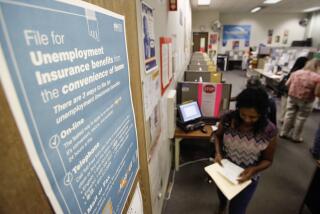Unemployment Claims Rise Sharply in Valley This Year
New claims for unemployment insurance in the San Fernando Valley hit an eight-year high between 2001 and 2002, suggesting a slow economic rebound from the national recession and the Sept. 11 terrorist attacks, according to a Cal State Northridge report being issued today.
Unemployment insurance claims in just the first two quarters of 2002 were 39% higher than for all of 2001, researchers said.
By comparison, the number of unemployed workers who sought benefits rose 25% between 2000 and 2001.
The spike in unemployment insurance claims does not necessarily mean the Valley is still in the grip of recession, researchers said, because unemployment rates tend to lag behind other economic indicators.
Economic forecasters predict that the number of unemployment insurance claims will begin to drop as normal seasonal employment patterns take hold and the region continues to build on a 2% increase in job growth that it posted last year.
“The unemployment numbers are at very high levels, and smart economic development policies that promote job growth would help address the current high unemployment numbers,” said Daniel Blake, director of CSUN’s San Fernando Valley Economic Research Center, which conducted the study.
The report also shows that there is a severe housing crunch in the Valley as demand continues to outstrip supply, resulting in rapidly rising home prices and rents, researchers said.
The median price for resale homes in the Valley hit $320,000 in June, compared to a median price -- meaning one half the prices are higher and one half lower -- of $279,000 for all of Los Angeles County, according to the report. The region’s average price of homes and condominiums was $355,000 in June 2002 compared to $295,000 in June 2001, a 20% increase.
Apartment vacancy rates, currently averaging 2.8% in the second half of 2002, have continued to decline since the 1994 Northridge earthquake and the recession of the mid-1990s.
The amount of available industrial space in the region rose throughout 2001 and into the first quarter of 2002, reaching a 5.5% vacancy rate before falling back to 5% in the second quarter of 2002.
Office vacancy rates currently are up 13% after falling to 9% in 2000.
The report, which is to be presented at today’s 14th annual business forecast conference of the Valley Industry & Commerce Assn., also illustrates the impact of the entertainment industry on the region, which shed some 8,800 jobs last year.
The entertainment sector accounts for slightly more than 105,000, or 16%, of private-sector jobs in the vast region that researchers examined, which includes the Valley, the community of Hidden Hills and the cities of Burbank, Glendale, Calabasas and San Fernando.
“We anticipate that the decline in 2002 will be followed by a recovery in 2003 that will be driven by the movie industry and technology sector,” said Jack Kyser, chief economist for the Los Angeles Economic Development Corp., who is expected to present his forecast at the conference.
The region will benefit economically from increased defense spending as the nation continues its war on terrorism, Kyser said.
“As these terrorist groups shift shape and try to get their hands on the latest technology, we will need to stay ahead of them,” he said. “Although most of the large aerospace manufacturing has gone, we are still strong in research and development and that will be driving what goes on in the years ahead.”
Also, he said, the outcome of the secession question will be a major factor in the economy as the focus is likely to intensify on issues including education, housing, infrastructure and water, among others.
More to Read
Sign up for Essential California
The most important California stories and recommendations in your inbox every morning.
You may occasionally receive promotional content from the Los Angeles Times.









